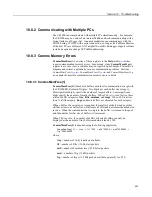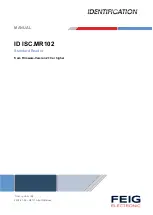
Section 10. Troubleshooting
frequently open and close a serial port, the probability is higher that a non-PakBus
character will arrive at the closed serial port, thus closing an existing talk-through
or comms watch session. If this occurs, the
FileManager()
setting to send comms
watch or sniffer to a file is immune to this problem.
10.11 Logs
Logs are meta data, usually about datalogger or software function. Logs, when
enabled, are available at the locations listed in the following table.
Table 134.
Log Locations
Software Package
Usual Location of Logs
LoggerNet
C:\Campbellsci\LoggerNet\Logs
PC400
C:\Campbellsci\PC400\Logs
DevConfig
C:\Campbellsci\DevConfig\sys\cora\Logs
10.12 Troubleshooting — Data Recovery
In rare circumstances, exceptional efforts may be required to recover data that are
otherwise lost to conventional data-collection methods. Circumstances may
include the following:
•
Program control error
o
A CRBasic program was sent to the CR1000 without specifying that it
run on power-up. This is most likely to occur only while using the
Compile, Save and Send
feature of older versions of
CRBasic Editor
.
o
A new program (even the same program) was inadvertently sent to the
CR1000 through the
Connect
client or
Set Up
client in
LoggerNet
.
o
The program was stopped through datalogger support software
File
Control
or
LoggerLink
software.
•
The CPU: drive was inadvertently formated.
•
A network peripheral (NL115, NL120, NL200, or NL240) was added to the
CR1000 when there was previously no network peripheral, and so forced the
CR1000 to reallocate memory.
•
A hardware failure, such as memory corruption, occurred.
•
Inserting or removing memory cards will generally do nothing to cause the
CR1000 to miss data. These events affect table definitions because they can
affect table size allocations, but they will not create a situation where data
recovery is necessary.
Data can usually be recovered using the
Datalogger Data Recovery
wizard
available in
DevConfig
(p. 111).
Recovery is possible because data in memory is not
usually destroyed, only lost track of. So, the wizard recovers "data" from the
entire memory, whether or not that memory has been written to, or written to
recently.
Once you have run through the recovery procedure, consider the following:
If a CRD: drive (memory card) or a USB: drive (Campbell Scientific mass storage
device) has been removed since the data was originally stored, then the
Datalogger Data Recovery
is run, the memory pointer will likely be in the wrong
location, so the recovered data will be corrupted. If this is the case, put the CRD:
504
Summary of Contents for CR1000
Page 2: ......
Page 4: ......
Page 6: ......
Page 32: ......
Page 36: ......
Page 38: ......
Page 40: ......
Page 60: ...Section 4 System Quickstart Figure 16 PC200W View Line Graph 60 ...
Page 96: ......
Page 98: ...98 ...
Page 302: ......
Page 453: ...Section 8 Operation Figure 115 Using the Keyboard Display 453 ...
Page 456: ...Section 8 Operation Figure 118 Real Time Custom 456 ...
Page 457: ...Section 8 Operation 8 8 1 3 Final Memory Tables Figure 119 Final Memory Tables 457 ...
Page 458: ...Section 8 Operation 8 8 2 Run Stop Program Figure 120 Run Stop Program 458 ...
Page 460: ...Section 8 Operation Figure 122 File Edit 460 ...
Page 461: ...Section 8 Operation 8 8 4 PCCard Memory Card Display Figure 123 PCCard CF Card Display 461 ...
Page 478: ......
Page 506: ......
Page 536: ......
Page 636: ......
Page 642: ......
Page 644: ......
Page 676: ......
Page 677: ......
















































